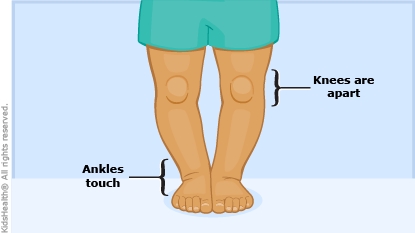Bow Legs (Genu Varum)
What Are Bow Legs?
Bow legs (or genu varum) is when the legs curve outward at the knees while the feet and ankles touch. Infants and toddlers often have bow legs. Sometimes, older kids do too.
It's rarely serious and usually goes away without treatment, often by the time a child is 3–4 years old.
What Are the Signs & Symptoms of Bow Legs?
Bow legs don't usually bother young children because the condition doesn't cause pain or discomfort. Parents might worry about the appearance of their child's legs, or an awkward walking pattern. But bow legs don't affect a child's ability to crawl, walk, or run.
Sometimes, kids with bow legs may walk with the toes pointed inward (called intoeing, or pigeon-toes) or they may trip a lot and appear clumsy. These problems generally resolve as the child grows.
If the condition lasts into teenage years, it may cause discomfort in the ankles, knees, or hips.

What Causes Bow Legs?
When babies are born with bow legs it's because some of the bones had to rotate (twist) slightly when they were growing in the womb to fit into the small space. This is called physiologic bow legs. It's considered a normal part of a child's growth and development.
As a child starts walking, the bowing might increase a bit and then get better. Children who start walking at a younger age have more noticeable bowing.
In most kids, the outward curving of the legs corrects on its own by age 3 or 4. The legs might even look curved inward (knock-knees). The legs usually straighten by age 7 or 8.
Rarely, bow legs can be caused by a more serious medical condition, such as:
- rickets, a bone growth problem due to lack of vitamin D or calcium. It's more common in developing countries where children don't get enough foods fortified with vitamin D.
- Blount disease, a growth disorder that affects the bones of the legs
- conditions that may affect bone growth around the knee including injury or infection
Who Gets Bow Legs?
Most infants and toddlers have at least some physiologic bowing of their legs.
Bow legs in older children usually is because of Blount disease or another medical condition. Blount disease is more common in kids who:
- are overweight
- started walking at an early age
- have a family member who had the condition
How Are Bow Legs Diagnosed?
Health care providers do an exam and ask about the child's medical history . They probably won't do any tests if the child is younger than 2 years old, feels well, and both legs are bowed to the same degree. Instead, they'll watch to make sure the bow legs gets better as the child grows.
Some kids might need to see an orthopedic doctor (bone specialist) if:
- The legs are not straightening on their own.
- The bowing is asymmetric (the legs are bowed to different degrees).
- The child has symptoms such as pain, limping, weakness, or trouble running.
An X-ray might be needed to look for Blount disease or rickets. If rickets is suspected, blood tests can help make that diagnosis.
How Are Bow Legs Treated?
- Physiologic bow legs does not need treatment. It usually corrects itself as the child grows.
- A child with Blount disease may need a brace or surgery.
- Rickets usually is treated by adding vitamin D and calcium to the diet. Rickets due to a genetic condition may need more specialized treatment by an endocrinologist (a doctor who treats diseases of the endocrine system).
What Else Should I Know?
Kids with physiologic bow legs don't need to limit their activities. They can run, walk, and be as active as other kids the same age.


